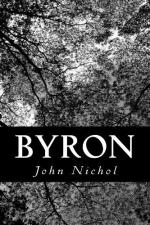This first lord was succeeded by his brother Richard (1605-1079), famous in the war for his government and gallant defence of Newark. He rests in the vault that now contains the dust of the greatest of his race, Hucknall Torkard Church, where his epitaph records the fact that the family lost all their present fortunes by their loyalty, adding, “yet it pleased God so to bless the humble endeavours of the said Richard, Lord Byron, that he repurchased part of their ancient inheritance, which he left to his posterity, with a laudable memory for his great piety and charity.” His eldest son, William, the third Lord (died 1695), is worth remembering on two accounts. He married Elizabeth, the daughter of Viscount Chaworth, and so wove the first link in a strange association of tragedy and romance: he was a patron of one of those poets who, approved by neither gods nor columns, are remembered by the accident of an accident, and was himself a poetaster, capable of the couplet,—
My whole ambition only does extend
To gain the name of Shipman’s faithful
friend,—
an ambition which, considering its moderate scope, may be granted to have attained its desire.
His successor, the fourth lord (1669-1736), gentleman of the bedchamber to Prince George of Denmark, himself living a quiet life, became, by his third wife, Frances, daughter of Lord Berkeley, the progenitor of a strange group of eccentric, adventurous, and passionate spirits. The eldest son, the fifth lord, and immediate predecessor in the peerage of the poet, was born in 1722, entered the naval service, left his ship, the “Victory,” just before she was lost on the rocks of Alderney, and subsequently became master of the stag-hounds. In 1765, the year of the passing of the American Stamp Act, an event occurred which coloured the whole of his after-life, and is curiously illustrative of the manners of the time. On January 26th or 29th (accounts vary) ten members of an aristocratic social club sat down to dinner in Pall-mall. Lord Byron and Mr. Chaworth, his neighbour and kinsman, were of the party. In the course of the evening, when the wine was going round, a dispute arose between them about the management of game, so frivolous that one conjectures the quarrel to have been picked to cloak some other cause of offence. Bets were offered, and high words passed, but the company thought the matter had blown over. On going out, however, the disputants met on the stairs, and one of the two, it is uncertain which, cried out to the waiter to show them an empty room. This was done, and a single tallow candle being placed on the table, the door was shut. A few minutes later a bell was rung, and the hotel master rushing in, Mr. Chaworth was found mortally wounded. There had been a struggle in the dim light, and Byron, having received the first lunge harmlessly in his waistcoat, had shortened his sword and run his adversary through the body, with the boast, not uncharacteristic of his grand nephew,




